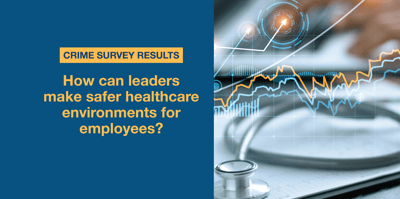Blog
Healthcare Security & Safety: Compliance & Joint Commission
Protecting those who care for patients is a fundamental healthcare industry value. Yet, a combination of complex factors contributes to the fact that healthcare professionals face a higher incidence of acts of workplace violence than any other workers in the U.S.
To comply with the U.S. Occupational Safety and Health Administration (OSHA), Joint Commission, and state regulatory requirements, healthcare facilities are required to effectively report, collect, monitor, and analyze workplace safety and security data — and put that data to work informing proactive prevention programs to improve safety and security.
Compliance management is essential to operations, but it’s also a gateway to the many benefits that arise when workplaces are safer and more secure, including:
- Better focus on patient care
- Enhanced employee health, satisfaction, and retention
- Increased efficiency and cost savings
- Improved HCAHPS scores and recognition from patients, visitors, and the community that your facilities are safe and secure
The safety and security of healthcare facilities are a cornerstone of public trust — and that’s why the protection of patients, staff, providers, visitors, and the general public is a top priority for healthcare systems across the country.
So, what does it take for your operations to build on a foundation of compliance to nurture a healthcare workplace culture of security and safety?
With so much to achieve, and so much on the line, it’s never been more important to make optimal use of the information, data organization, and communication resources available in a security management software system.
In this article, we’ll take a closer look at how your security management software can support these crucial goals.
 Compliance Sets the Bar: Meet Changing Regulations and Standards
Compliance Sets the Bar: Meet Changing Regulations and Standards
A safe, secure workplace is a value, but it’s more than that: it’s the regulatory standard, and it’s the law. The OSH Act requires employers to comply with OSHA regulations or OSHA-approved state standards. The Act’s General Duty Clause “requires employers to provide their workers with a workplace free from recognized hazards that are causing or likely to cause death or serious physical harm.”
As of January 1, 2022, The Joint Commission’s accreditation requirements will include new and revised workplace violence prevention standards. The Joint Commission defines workplace violence in detail, noting that it may include “verbal, nonverbal, written, or physical aggression; threatening, intimidating, harassing, or humiliating words or actions; bullying; sabotage; sexual harassment; physical assaults; or other behaviors of concern involving staff, licensed practitioners, patients, or visitors.”
 Meeting OSHA & Joint Commission Standards & Guidelines
Meeting OSHA & Joint Commission Standards & Guidelines
OSHA Standards & Guidelines
OSHA’s Roadmap for Healthcare Facilities cites the most important characteristics of a workplace violence prevention:
- Management commitment and worker participation
- Worksite analysis and hazard identification
- Hazard prevention and control
- Safety and health training
- Recordkeeping and program evaluation
This list makes it easy to see the complexity and depth required to successfully create and manage a solid program.
Joint Commission Standards & Guidelines
Similarly, The Joint Commission Hospital Violence Prevention Standards set an expectation that accredited healthcare facilities demonstrate the establishment of an environment of care, to incorporate human resources into the overall safety and security practices, and for leadership to establish a culture of safety. Those expectations point to managing safety and security risks, collecting information to monitor the environment, providing ongoing training and education — and, for those tasked with accreditation audits, demonstrating that all this work is ongoing.
Documenting employee participation at all levels, logging hazard identification and improvements, managing ongoing training requirements, and keeping records up to date all have the potential to create tremendous administrative burdens on already time-strapped employees.
But your choice of security management software can make a difference. The right tools can make it faster and easier to achieve more “yes” answers on OSHA’s Workplace Violence Prevention Program Checklist and reduce the amount of administrative time needed to achieve those goals.
Your tools should also enable your healthcare workplace leaders to approach accreditation audits with confidence in your documentation and the ability to quickly and simply answer auditors’ questions and provide records on demand. After all, your compliance documentation should always be at your fingertips — not buried in a stack of boxes behind a desk in an HR office.
 Complete, Organized, Easy-to-Analyze Data Can Help Solve Compliance Challenges
Complete, Organized, Easy-to-Analyze Data Can Help Solve Compliance Challenges
Let’s face it: Healthcare security and safety is uniquely challenging, and it’s impossible to fix a challenge without effectively quantifying, assessing, and defining it. Some obstacles in the way include a lack of:
- Clarity about what constitutes an incident of workplace violence
- Awareness of all the details required in reporting
- Reporting systems
- Training
Even if you have a hazard and incident reporting system in place, it could be too clunky or hard to use, especially in emergencies. Or employees may have concerns about privacy, confidentiality, and controls over who has access, and that could keep them from reporting incidents appropriately.
Employees’ fears of retaliation for reporting, or perceptions that violence is an expected part of their jobs, can only be eliminated over time with leadership’s participation and a program that demonstrates measurable, reportable improvements. And that’s just what the right software solution can help deliver.
 Compliance-Supporting Features to Look for In Security Management Software
Compliance-Supporting Features to Look for In Security Management Software
Security management software can play a critical role in establishing, implementing, and continuously improving your organization’s safety and security programming — but only if the solution is developed with purpose-built features that make it intuitive and easy to use. Your software solution should make documentation quick and simpl for all users, yet control access permissions to ensure confidentiality and protect privacy. It should make it just as easy to report and analyze data as it is to collect and store it.
Look for features and functionality that enable your teams to:
- Develop and integrate de-escalation and decision-making workflows
- Increase response effectiveness in the event of an emergency
- Improve investigative response time after an incident
- Control permissions to offer anonymity in reporting
- Integrate with security systems and patrols
- Categorize incidents for effective, meaningful analysis and reporting
Your software solution should be helpful in identifying trending risks and hazards to create opportunities for your effective, proactive prevention program.
 Establish and Demonstrate Your Environment of Care
Establish and Demonstrate Your Environment of Care
In 2018, healthcare workers accounted for 73 percent of all nonfatal workplace injuries and illnesses due to violence — a statistic that is likely severely underreported.
The costs of safety and security failures in the healthcare workplace can have a negative impact on employees’ ability to care effectively for patients. It can also lead to increasing work stress, job dissatisfaction, lost time, and employee turnover.
On the flip side, workplaces that lead the industry in continuous improvement of their security and safety programs can stand to gain from increased job satisfaction, lower costs, and better patient care.
Documenting and demonstrating compliance with regulatory standards and guidelines is essential, but it’s just the beginning of your comprehensive workplace security and safety program. Your incident reporting software can serve as the backbone of a proactive, effective healthcare workplace violence prevention program. Explore how Omnigo’s Safety and Security Solutions for Healthcare Providers can help you meet and exceed regulatory standards, meet the Joint Commission national patient safety goals, and become a leader in creating an Environment of Care. Request a product demonstration today — just click the link below.
More from the blog
View All Posts
How can leaders make safer healthcare environments for employees?
Read More
Preventing Hospital Workplace Violence: A Look at New Requirements From The Joint Commission
Read More
5 Steps to Improving Healthcare Worker Well-Being [Plus Bonus Tips]
Read MoreSubscribe to email updates
Stay up-to-date on what's happening at this blog and get additional content about the benefits of subscribing.
